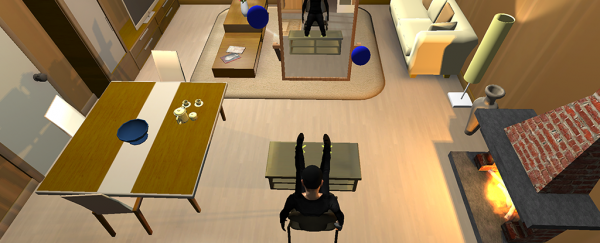Researchers have found that producing the illusion of an out-of-body (OBE) experience is helping people deal with their anxiety over dying.
While being forced to confront one's demons can be an effective way to treat phobias, it can often be impractical, if not downright unethical. But since its resurgence in the 1990s, virtual reality has been used to conjure up stressful yet safe scenarios in treatment of anything from a fear of heights to crippling arachnophobia.
Previous research had already shown that patients who reported a sensation of leaving their body while clinically dead ended up experiencing a reduced fear of dying after being revived - perhaps due to an impression that their life would continue on in some capacity.
In this case, researchers from the University of Barcelona in Spain used immersive VR to give volunteers a virtual out-of-body experience to see if it could reduce their fear of death.
The team divided 32 women into two groups, and suited them up with Oculus Rift virtual reality headsets, movement trackers, and vibrating wrist and ankle bands. The reclining volunteers could see a 3D digital environment, as well as a model of their body through their headsets.
Matching their virtual body's movements with their own further added to what's referred to as a 'body ownership illusion'. It's like a more full-body version of the famous rubber hand illusion - a favourite party trick in science museums, where people can be confused into feeling a fake hand is their own.
Lastly, a floating ball tapped against the volunteer's wrists and ankles in time with a vibration through their wrist and ankle bands, providing one more piece of sensory information to the illusion.
Once immersed in this digital landscape, the volunteers would watch their viewpoint slip out of their virtual body, towards the ceiling.
Half of the volunteers continued to feel the tap of the ball against their ankles and wrists as they watched from above. The other half acted as the control group and felt nothing, simply watching their body as it was tapped with the floating balls.
A follow-up questionnaire probed the volunteers on their experience and their fear of death.
Only those who continued to feel the vibration of the ball tapping against their wrists and ankles felt as if they were still connected to their bodies as their perspective shifted - a sensation resembling an out-of-body experience.
These same volunteers also later reported a reduction in their fear of dying.
Both groups of volunteers had reported an average fear of about 6 out of 7 prior to the experience. Those who had a virtual out-of-body experience reported their fear of death to be just 2.5 out of 7 - slightly less than the control group's 3 out of 7.
So while the difference between the group with the balls tapping against their wrists and ankles and the control group wasn't huge, both groups saw a significant decrease in their overall fear of death.
"Our results open up the possibility that the virtual OBE experience provides an implicit learning that consciousness in the sense of the centre of perception can be separate from the physical body, and that therefore death of the physical body is not necessarily the end of consciousness," the researchers write.
Of course, while this could be good news for those whose phobia over dying interferes with their joy of living, it raises some meaty questions over the ethics of inspiring belief in the supernatural to cope with fear and anxiety.
The study is far from conclusive, relying on a very small sample size consisting of women only, but it hints at the potential of using virtual reality for dealing with a rather abstract and confronting fear.
The next big question is whether there'll be a virtual reality therapy to help gamers get over their fear of using virtual reality.
This research was published in PLOS One.
